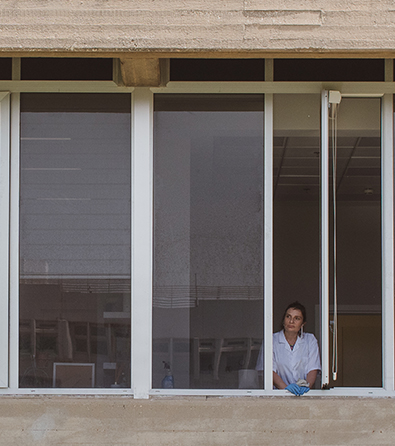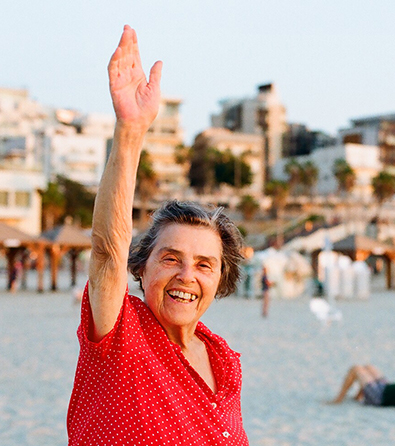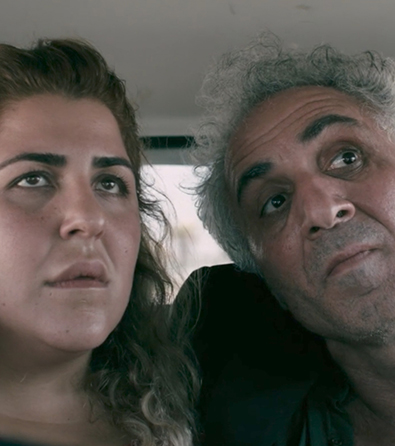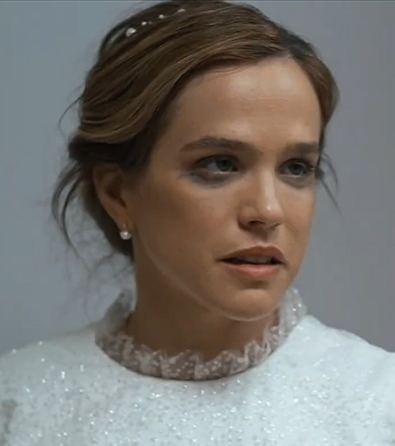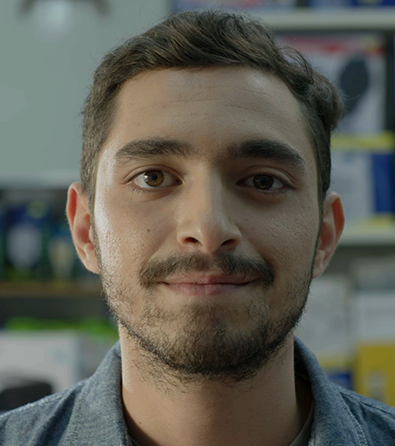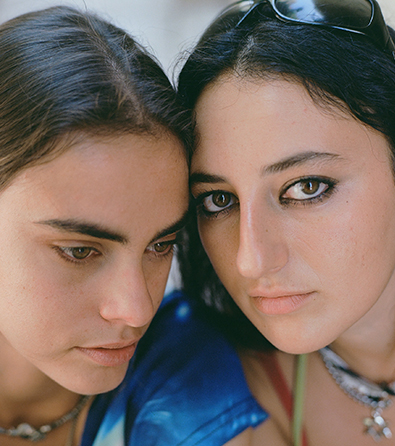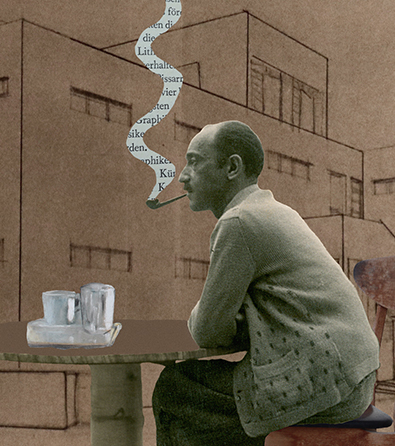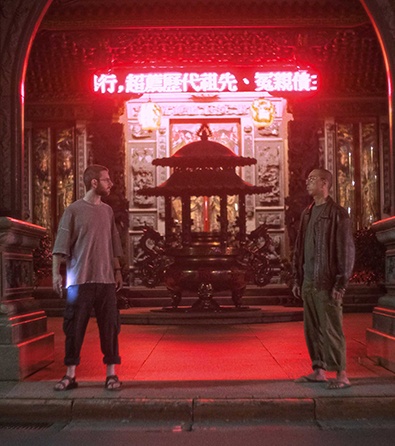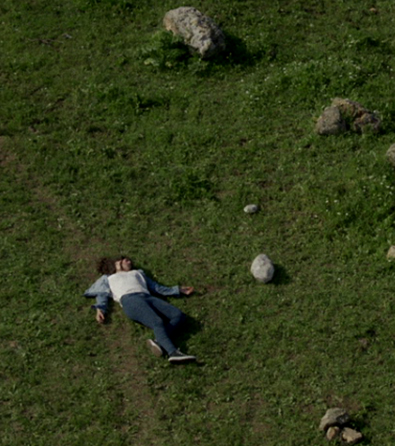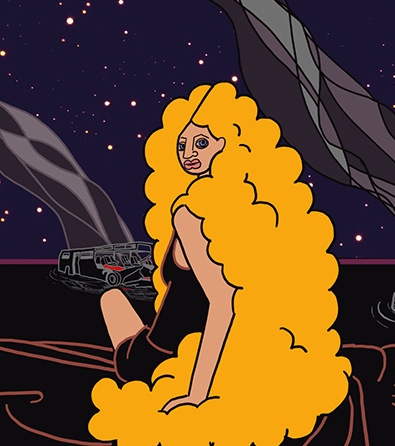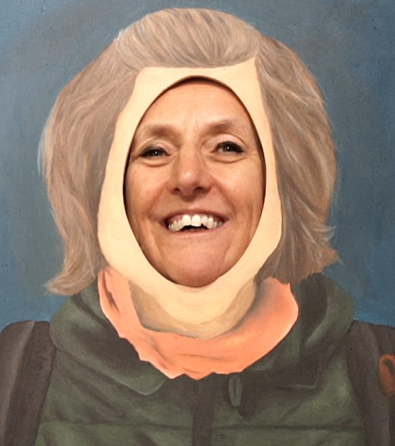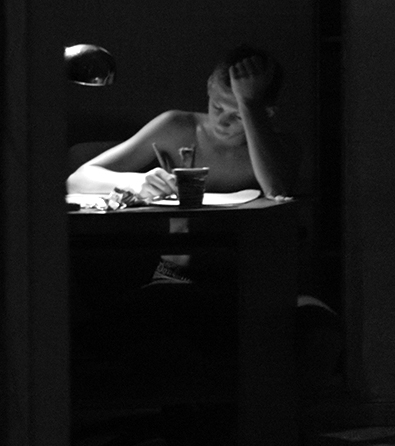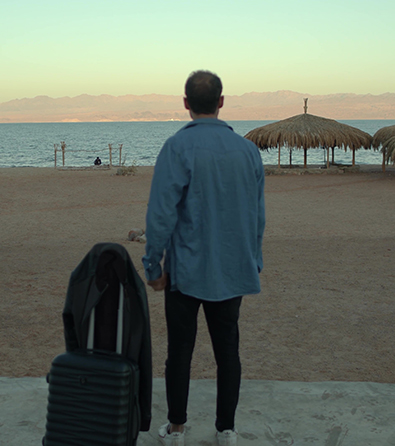The video art Rehearsing the Spectacle of Spectres (10 minutes) is available at the top of the page.
* To watch this film, please approve YouTube/Vimeo cookies via the blue cookie icon at the bottom left of the screen.
The video art by artists Nir Evron and Omer Krieger, Rehearsing the Spectacle of Spectres, was created in 2014 following an initiative by Dr. Ziva Jelin, the curator and manager of the art gallery at Kibbutz Be’eri, Israel. During that period, the gallery participated in a series of seven exhibitions named “Bamidbar Devarim,” (Hebrew: ‘Sayings in the Desert’, also the names of the two last books of the Torah – Numbers, Deuteronomy) held in the kibbutzim located in the south of Israel and at the Negev Museum of Art.
Evron and Krieger, who have collaborated for many years, responded to Jelin’s initiative by proposing a film that straddles the line between documentary and video art. They visited Kibbutz Be’eri that year to research its history, focusing on the art created in the kibbutz and the artists residing there. They chose to involve the members and artists of Be’eri in both the research and the film, starting from a documentary perspective. This approach explores the essence of the kibbutz in a broad ontological sense and as a place of fundamental contradictions: on one hand, the kibbutz is based on a stunning and exciting utopian idea, yet on the other, it embodies the potential for the disintegration of its communal life; it is a root space closely tied to the politics, history, and modernity of Zionism, yet also the private and personal home of many families in the present; it promotes an exemplary lifestyle full of hope and vision, yet is imbued with the melancholy of the end of the kibbutz era and lies on the border of the Gaza Strip.
These reflections on the kibbutz’s existence in general, and Be’eri in particular, led to the visual statement of intent of the film, which focused on the material and visual culture of Kibbutz Be’eri. For example, the film presents the architecture of the dining hall, the community center, and the amphitheater. It deals with the history of art and culture in the kibbutz as a social and political avant-garde.
During their research, Krieger and Evron viewed dozens of archive films shot in kibbutzim, including celebrations and ceremonies reflecting a life of spirit and matter based on collaborative creation. They sought out artists living in the kibbutz, leading them to the poet Anadad Eldan, who wrote poetry books, librettos for kibbutz ceremonies and plays and was for many years the Bible and literature teacher for generations in the kibbutz.
They discovered in his books a poem that served as the basis for the film and asked members of the kibbutz to read it as a soundtrack against the backdrop of drone footage surveying the kibbutz. The drone was a self-aware aesthetic and thematic choice, as the villages surrounding Gaza and the skies of Be’eri were often filled with the humming of IDF surveillance drones day and night. In the film, these drones become part of the audio-visual experience of the place.
The film was exhibited in February 2014, approximately half a year before military Operation Protective Edge, and it both opens and closes with shots of the city of Gaza and the border. Even at its presentation, the work possessed a prophetic dimension. The ability of art to predict the future and its cognitive and emotional impact on the viewer has intrigued many researchers and art enthusiasts. An artist’s capacity to capture a future moment in the life of a nation or a collective is a uniquely exciting quality, evoking curiosity, mystery, and a sense of secrecy.
Ernst Gombrich, a Jewish-Austrian art historian in the 20th century, explored the connection between history and art and the ability of art to foresee the future seemingly. Gombrich posited that viewing a work of art triggers a fascinating cognitive and emotional activity in the audience: they see the work, which then activates their memories and experiences, prompting them to reflect on their past, present, and future. Concerning the future, Gombrich suggested that a work of art creates possibilities for the viewers, some of which resonate with their deepest fears or desires. These reflections are projected back onto the work of art and will only be clarified or confirmed as time unfolds.
In viewing Rehearsing the Spectacle of Spectres, multiple timelines emerge, relating both to the emotional and cognitive impact of a decade in Kibbutz Be’eri from 2013 to October 7, 2023, the day of the Hamas massacre, as well as to the past and future of the kibbutzim and the State of Israel. The term ‘Rehearsing’ in the title signifies entering a rehearsal room for a work of art and a return to the vision – encompassing both past and future, reality and illusion.
During the filming in 2013, Krieger and Evron had members of Kibbutz Be’eri read Eldan’s poem while listening to Eldan himself recite it through earpieces, repeating after him:
“While rehearsing his spectacle of specters she rehearsed recalling his departure at sunrise
a waste of time winning his ear just like the time with the shopkeeper to gain his irreverent gold
commanded the tortoise to run and then to stop next to him he stepped
and he forged consonants his coffer confabulated out of step step cadences
from the swamp between the ribs she surfaced who had submerged in you
and you are constrained not shouting hunting for the forms that scamper outside”
In the opening section of the poem, one can discern the unique combinations of phonemes that Eldan skillfully composed, using the Hebrew letters Zayin (ז’), Tsadi (צ’), Ayin (ע’), and Aleph (א’) deliberately and extensively. These letters are paired in resemblance: Zayin is close to Tsadi, and Ayin to Aleph. Additionally, throughout different parts of the verse, one of these consonants is repeated in every word, creating a repetitiveness of the same sound in different words – in this case, Zayin and Tsadi. This repetitiveness and the combinations of these phonemes in Hebrew compel the speaker to perform a physical action while speaking: to bring the air from the throat to the tongue, which then strikes the teeth. This action is challenging for the modern Hebrew speaker, who typically avoids repetitive combinations of these phonemes due to pronunciation difficulties.
Eldan invites the reader to engage in a linguistic exercise, thereby experiencing the core of the Hebrew language and its phonemes. This approach is reminiscent of children’s songs from the era of the state’s establishment, which often included a linguistic exercise focused on a letter, word, or sound from the Hebrew language to facilitate easy learning and memorization for children.
The events Eldan writes about are far removed from the life experiences of early childhood, and it is evident that they are written from a perspective enriched by many years, reflecting on human relationships, nature, and inanimate objects. Eldan navigates both the connection and the dissonance between the literary and artistic spiritual life of his private and personal existence and the agricultural, communal, and collective life of nature:
“inside free of fierce meanders in the orifice to a soul that is sinful and hurt
like a shade plant sprouting leisurely squelched by hyper selfhood out of tender necessity
don’t expedite excessively decisive don’t carve secrets shredded in planter pots
that I have placed to be formulated between weeds and a book limply to spread dust over a page
the storm that flips my pages is disturbed as I fall picks through my branches persimmon in my verses”
In the poem, the narrator reveals the nuances of his soul, detailing the survival actions he performs in everyday life to find a balance between the life of the spirit and the material life. The kibbutz members read like a choir of individuals, their voices resonating simultaneously as both the voice of the collective and the voices of individuals. At the end of the work, Anadad Eldan’s voice emerges as the voice of the individual, set against the backdrop of the faces of the kibbutz members. Evron and Krieger filmed the kibbutz members reading the poem, creating an image composed of the faces of all the participants separately and also a collective image where the faces of the kibbutz members were combined, one on top of the other.
Today, following the Hamas massacre and the war crimes committed against the kibbutz members in their homes, public, private, and agricultural spaces, the work takes on prophetic connotations that emphasize the destruction and devastation of both soul and body. The personal words of Anadad Eldan pierce the collective heart of the Be’eri community, becoming a national text in the life of all of Israel.
In conversation with Evron and Krieger, they express concern that the film might be viewed and interpreted today in a manner focused solely on horror and destruction. At the same time, the nuances and subtleties about beauty, hope, and promise in kibbutz life might be overlooked entirely. The different levels of memory represented in the film – past, present, and future – embody a diversityof voices, ideas, and complex emotions towards the kibbutz’s ideological realism typically expressed in its art.
The work of Krieger and Evron belongs to a respected tradition of artists in the public sphere, which carries social implications and extends the discussion about the collective beyond historians and politicians to include civil society. This is evident in the faces of the kibbutz members participating in the film. It is particularly poignant to discover that one of the filmed participants, the late Hagai Avni, a member of Kibbutz Be’eri’s volunteer guards, was murdered in the fight to defend the kibbutz. The social and collective fabric of Kibbutz Be’eri was torn apart, not due to the deterioration of kibbutz communalism or economics, but because of the massacre carried out by Hamas.
Since its creation in 2014, the film has been showcased at various prestigious venues. It was featured at the Herzliya Museum in the “Preaching to the Choir” exhibition, curated by Maayan Sheleff, and at the Circle 1 gallery in Berlin. In Berlin, the work was presented in a solo exhibition of Krieger and Evron, including a film over two hours long that the duo edited from representations of the kibbutz in both fictional and documentary cinema. Since October 21, just fourteen days after the massacre, the film, which received extensive coverage in both Israeli and international media, has been screened at the Jewish Museum in Berlin. Last weekend (November 17–19), it was shown at the Maxxi Museum in Rome, and in the coming months, it is scheduled to be presented in London, Frankfurt, and other cities.
The exhibition curator, Dr. Ziva Jelin, who survived the massacre, relocated the surviving works of the gallery to Beit Romano in Tel Aviv. Anadad Eldan, aged 99, and his wife Sari, aged 88, also survived the massacre and were moved to temporary housing along with the surviving members of the Kibbutz Be’eri community. In another poem by Eldan, he reflects on the tragedy:
“On Be’eri’s walls, I wrote her story.
from origins and depths wrenched from the cold
they now read what happened in pain, and her light
that fell into the mist and darkness of night and a primeval cry
for a prayer, her children have fallen and a door is locked
for the grace of heaven, they breathe desolation and sorrow
Who will comfort inconsolable parents for a curse
whispers may you have neither dew nor rain and whoever is able may weep
There is an hour when darkness roars, but there is dawn and radiance.”
The video art Rehearsing the Spectacle of Spectres is available to watch at the top of the page.
